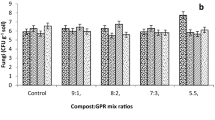Abstract
The biodegradation of different peat types was studied with a manometric respirometric test. Compaction peat and sphagnum peat samples were analysed, and the effect of peat pH on biodegradation behaviour was evaluated. Only minor (BOD/ThOD < 0.4%) biodegradation was observed with compaction peat samples, and the stable state, in which biodegradation stopped, was achieved during a two month period. As expected, sphagnum peat samples with a lower decomposition rate degraded more than compaction peat samples. Alkalinity (pH between ca. 4–9) of the peat was noticed to reduce the degree of biodegradation and accelerate the achievement of the stable state.




Similar content being viewed by others
References
Aho, M. (1986). The Ion Exchange And Adsorption Properties of Sphagnum Peat Under Acidic Conditions. Research report No. 24. Department of Chemistry, University of Jyväskylä. ISBN 951-679-533-1, ISSN 0357-346X.
Brown, P., Gill, S., & Allen, S. (2000). Metal removal from wastewater using peat (Review paper). Water Research, 34, 3907–3916.
Councill Directive 1999/ 31/EC of 26th April 1999 on the landfill of waste. Official Journal L 182, 16/07/1999, 0001–0019.
Council of State Decree on landfill (1049/1991, 552/2001, 202/1996).Ministry of the Environment.
Council of State of landfills 861/1997 Ministry of the Environment.
Dean, S., & Tobin, J. (1999). Uptake of chromium cations and anions by milled peat. Resources, Conservation and Recycling, 27, 151–156.
EPA (1992). Batch-Type Procedures For Estimating Soil Adsorption of Chemicals. Technical Resource Document. EPA/530/SW-87/006-F. United States Environmental Protection Agency, EPA.
Gabaldon, C., Marzal, P., & Alvarez-Hornos, F. (2006). Modelling Cd(III) removal from aqueous solutions by adsorption on a highly mineralized peat. Batch and fixed-bed column experiments. Journal of Chemical Technology and Biotechnology, 81, 1107–1112.
Glooschenko, W., & Copobianco, J. (1982). Trace element content of northern Ontario peat. Environmental Science and Technology, 16, 87–188.
Ho, Y., & McKay, G. (1998). The sorption of lead (II) ions on peat. Research note. Water Research, 33, 578–584.
ISO 10390:2005: Soil quality – Determination of pH.
Kaakinen, J., Vähäoja, P., Kuokkanen, T., & Roppola, K. (2007). Studies on the effects of certain soil properties on the biodegradation of oils determined by respirometric method. Journal of Automated Methods and Management in Chemistry, ID 34601, 1–7.
Kuokkanen, T., Vähäoja, P., Välimäki, I., & Lauhanen, R. (2004). Suitability of the respirometric BOD Oxitop method for the determining the biodegradability of oil in ground water using forestry hydraulic oils as model compounds. International Journal of Environmental Analytical Chemistry, 84, 677–689.
Ma, W., & Tobin, J. (2003). Development of multimetal binding model and application to binary metal biosorption onto peat biomass. Water Research, 37, 3967–3977.
Method P12871/2. (1997). The Plant Production Inspection Centre of Finland, Department of Agricultural Chemistry, Inorganic Laboratory, in Finnish.
OECD guideline for testing the chemicals (Section 3: Degradation and Accumulation, Test 301: Readily biodegradability). Updated Guideline, adopted 17 July 1992, OECD, France.
OxiTop® operating manual. (1998). WTW Weilheim, Germany.
Pakarinen, P., Tolonen, K., & Soveri, J. (1981). Distribution of trace metals and sulfur in the surface peat of Finnish raised bogs. In Proceedings of the Sixth International Peat Congress, Duluth, Minnesota. Fisher, Eveleth, Minn., 645–648.
Platen, H., Wirtz, A. (1999a). Applications of analysis no. 1; Measurement of the respiration activity of soils using the OxiTop® Control measuring system. Basic principles and process characteristic quantities.
Platen, H., Wirtz, A. (1999b). Applications of analysis no. 2; Measurement of the respiration activity of soils using the OxiTop® Control measuring system. Standard test preparation.
Puustjärvi, V. (1973). Kasvuturve ja sen käyttö. Turveteollisuusliitto (TTL).
Shackleford, C. D. (1988). Diffusion as a Transport Process in Fine-Grained Barrier Materials, Geotechnical News, June, 24–27.
Sharma, H., & Lewis, S. (1994). Waste Containment Systems, Waste Stabilization and Landfills, Design and Evaluation. John Wiley & Sons, p. 588.
Vähäoja, P., Kuokkanen, T., Välimäki, I., Vuoti, S., & Perämäki, P. (2005a). Biodegradabilities of some chain oils in groundwater as determined by the respirometric BOD OxiTop method. Anaytical and Bioanalytical Chemistry, 381, 445–450.
Vähäoja, P., Piltonen, P., Hyvönen, A., Niinimäki, J., Jalonen, J., & Kuokkanen, T. (2005b). Biodegradability of certain wood preservatives in groundwater as determined by the respirometric BOD Oxitop method. Water, Air and Soil Pollution, 165, 313–326.
Vähäoja, P., Roppola, K., Välimäki, I., & Kuokkanen, T. (2005c). studies of biodegradability of certain oils in forest soil as determined by the respirometric BOD oxitop method. International Journal of Environmental Analytical Chemistry, 85, 1065–1073.
Wandruzka, R., & Newell, D. (2002). Removal of zinc and trichloroethylene from water by column extraction with a crude humic acid. Environmental Progress, 21, 209–214.
Waste Act 1072/1993. Ministry of the Environment.
Waste Decree 1390/1993. Ministry of the Environment.
Acknowledgements
The authors would like to thank Suomen Ympäristöpalvelu Ltd. and especially MSc. Ilkka Välimäki for the chemical analyses, Mrs. Hanna Prokkola for the help during the biodegradation measurements as well as Mr. Ilkka Ilmavirta from Vapo Oy for helpful discussions concerning peat products and PhD Jaakko Rämö for helpful discussions concerning BOD studies. Thanks also to MSc. Ilari Sohlo for text-editing the English.
Author information
Authors and Affiliations
Corresponding author
Rights and permissions
About this article
Cite this article
Roppola, K., Kuokkanen, T., Kujala, K. et al. Utilization Potential of Peats – a Study on Peat Biodegradability Determined by Respirometric Method. Water Air Soil Pollut 192, 59–66 (2008). https://doi.org/10.1007/s11270-008-9634-y
Received:
Accepted:
Published:
Issue Date:
DOI: https://doi.org/10.1007/s11270-008-9634-y




